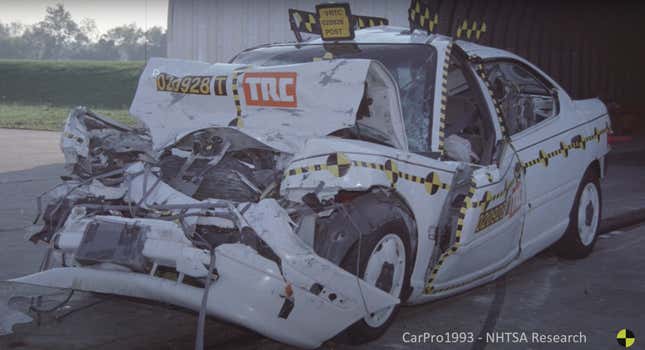22-Year-Old Crash Test Shows The Dangers Of Big SUVs Have Been Around For Years

Full-size SUVs seem to be more massive than they’ve ever been, and it’s not just a single automaker that’s guilty of it — they basically all are. From Jeep’s Wagoneer models to Toyota’s Sequoia and GM’s full-size SUVs, if you get into an accident with one of these things, you’re cooked. What’s remarkable about these SUVs is that the dangers of them have been known for years, as this 22-year-old crash test shows.
The Corvette Generations Ranked, By A Gen Zer
Now, big SUVs aren’t just dangerous in crashes because they’re big overall. There’s actual data to support that larger hood, grille and front fascia areas make vehicles more dangerous. In the early 2000’s, however, this was still being studied and put to the test.
1999 Lincoln Navigator Into 1996 Dodge Neon Full Overlap Frontal Crash Test
In a video from YouTube’s CarPro1993 Crash Test Archives, the Transportation Research Center in Ohio performed a crash test in 2002 using a 1999 Lincoln Navigator and a 1996 Dodge Neon sedan in a 30-mph frontal crash. The description of the test says that its purpose was to evaluate “the aggressiveness of the bullet vehicle, a 1999 Lincoln Navigator SUV, and the vehicle and occupant response of the target vehicle, a 1996 Dodge Neon 4-door sedan, in this vehicle-to-vehicle impact mode.” The results are shocking.
Screenshot: CarPro1993 – Crash Test Archive YouTube
Just looking purely at specs you’ll see the Neon was at a disadvantage. This first generation of Navigator is a full 22.4 inches taller than the Neon sedan, and the front of the Navigator lines up directly with the front windshield of the Neon. Both cars were run at 30 mph, but the way the Neon is damaged makes it seem as if both were going much faster.
As you can see in the slow-motion portion of the video, the Neon damn near acts as sort of a ramp for the Navigator. The big Lincoln’s front wheels plow so far into the Neon that both vehicles’ wheels touch. Meanwhile, the Neon bends upward at the rear of the front fender where it meets the A-pillar. It’s a shocking amount of damage considering its relatively low-speed impact.

Screenshot: CarPro1993 – Crash Test Archive YouTube
Meanwhile, the Navigator and its occupants held up much better. Most of the damage on the Navigator looks to be concentrated under the vehicle, and given where the occupants were sitting due to the SUV’s height, they had more protection.
The occupants of the Neon weren’t so lucky. The video details how the occupant dummies in the Neon experienced some forces that exceeded the limits set by Federal Motor Vehicle Safety Standards, especially in regards to G forces. For instance, there were 65 g’s of chest force experienced in the Neon; federal safety standards say that should not surpass 60 g’s.
Even though this is an old test, it should be a wake-up call to both drivers of small cars and drivers of large vehicles and SUVs to drive safely, especially if you’re in an older vehicle with worse safety features and structures. One could only imagine how a crash like this would play out in today’s even bigger vehicles.

Screenshot: CarPro1993 – Crash Test Archive YouTube



